This is Part 2 of three tutorials about how to construct a Putz house or “little glitter house” as they are sometimes called. This tutorial is meant as a guide to the way I construct a Putz house. Keep in mind that I have my own style and my own techniques, and the following directions will reflect that. Other Putzers have their own styles and techniques, so don’t take this as the only way to make a Putz. Or as the only way a Putz house should look. Everyone brings something to the table. Use what works for you. Change what doesn’t.
Part 1 covered cutting the pattern and installing the window panes.
how to make a putz house / part 1 of 3 / from pattern to ready to assemble
This post, Part 2, covers assembling the house and painting it.
I will post Part 3 as soon as I have it completed. It will cover attaching the Putz to a base and embellishing the Putz with a fence, trees, snow, glitter, etc.
The list of tools needed for the three parts of this tutorial can be found in Part 1.
For the purposes of these tutorials, I am using the pattern I designed and drafted for this Christmas Tree Lot. Follow the directions and you can add this cute Putz to your own collection, proudly created by you! I’m going to make you work for it, though. You learn more by doing, so you get to draw your own copy of the pattern. The tutorial for drawing this pattern is here:

Part 1 of this tutorial showed how to cut the pattern, prepare the Putz pieces for assembling and adding window glazing. Now it’s time to glue the building together. I use hot glue, but that requires quick work. The hot glue sets immediately and leaves no time for wiggle room. If you aren’t familiar with the way the Putz needs to fit together, it could be stuck incorrectly and that is hard to correct when using hot glue. I would recommend new-to-the-hobby Putzers use tacky, white glue. It takes a short time to set (20-30 seconds or so, depending on the glue), but that gives time to move the pieces into the correct position.
Start by gluing the base to the walls. I like to start with the side.
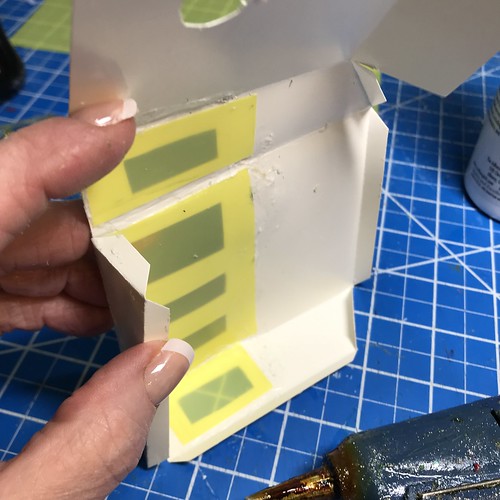
It’s a good idea to take a moment to decide what is being glued to what and to see how it fits together.

Apply the glue to one flap at a time.

Glue all the base flaps to the Putz, then glue the side seam.

The flap that makes the roof support is something I like to add to patterns to help give stability to the Putz house. Not all Putz patterns include support flaps. It should be glued to the top of the Putz. Avoid overlapping where part of the support would stick out past the flaps it is glued to. Those overlaps will affect the straight lines of the building.

NOTE: Don’t worry about the bumps and rough areas on the outside of the building, if you plan to add sand to the paint to make a vintage-style texture on the Putz house. More about that later in this tutorial. If you choose not to use sand for texture, keep the outside of the Putz as clean as possible.

Set the Putz aside and cut out the remaining parts of the pattern. I save and use scraps of chipboard for cutting small pieces like the circle frame for the light opening. As shown in Part 1, use a dab of adhesive tape to hold the pattern to the chipboard while cutting out the pattern piece.

I cut the inside circle just inside the cutting line so the frame will be a tiny bit larger than the hole in the back of the Putz house.

I use scissors to cut the outside of the frame on the pattern line. Going slowly increases accuracy.

The chimney can be cut along the straight sides with an acyrlic ruler and the X-acto knife or cut it with scissors. Do what works best for you.


Score the dashed lines and fold.
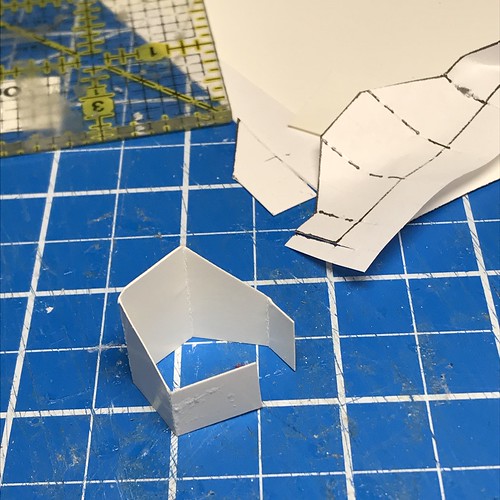
Glue the chimney together.

The chimney cap is marked from corner to corner to help with punching a hole in the center.

Sometimes I punch a small 1/8″ hole and sometimes a 1/4″ hole. It doesn’t matter what you use. The cap and/or the hole are optional and can be left off the chimney if desired.

Cut the window and door frames. Again, I align the long straight edge of the pattern with the edge of the chipboard. If you aren’t sure if the edge of the chipboard is perfectly straight or not, you can cut it with the acrylic ruler before cutting the frames.
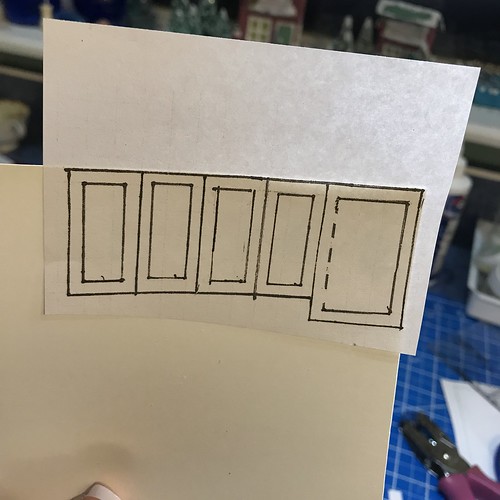
I cut all the lines that run in the same direction first, then turn the piece and cut the ones that run in the opposite direction. Saves time.

In this picture, the three sides of the door have been cut inside the door frame, and the four windows have been cut out.
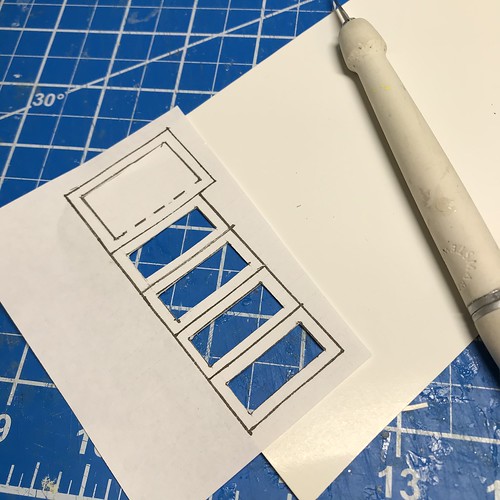
I cut the door apart from the windows because it is a different height than the window frames. Then I cut the long lines of the windows.

Score and fold the door. I fold it all the way back and use the bone folder to crease the fold. That helps hold the door open a bit after it’s painted.

The door can be placed so the door opens on the left or the right.

When placing a door, I take my cue from the house. In the spring Putz houses below, note the placement of the doors. On the two houses to the outside, the doors are placed so they open away from the bulk of the house. The door on the church, in the middle of the picture, doesn’t open away from the bulk, because the tower is set back from the front edge of the building and it made sense to me that the door should open so it sits against the building rather than to the outside of the Putz. But that’s all personal choice. The door can be placed to open in the direction that makes sense to you. Because the Christmas Tree Lot door is rectangular, it can be used either way, opening right or left. If the door were rounded on top, like the door on the yellow house below, the fold in the door needs to be placed on the correct side before cutting the pattern piece because it won’t work upside down. Just a detail to be aware of when cutting out doors.

Cut between the windows, then pull the paper pattern off the frames.


As I cut these small pieces, I contain them in a box to keep everything together. The pieces are easy to lose on top a craft desk! The little house in the background is contained in a small, clear plastic box.
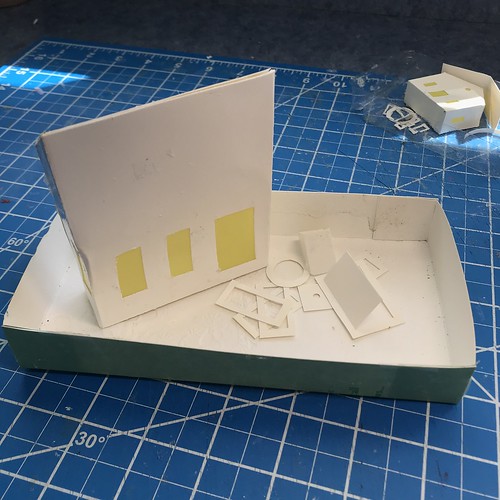
When I paint a Putz house, I use a flap from a cardboard box to paint the pieces on. I use the cardboard over and over until there’s too much paint on it. Then I pitch it and start over with a new flap.
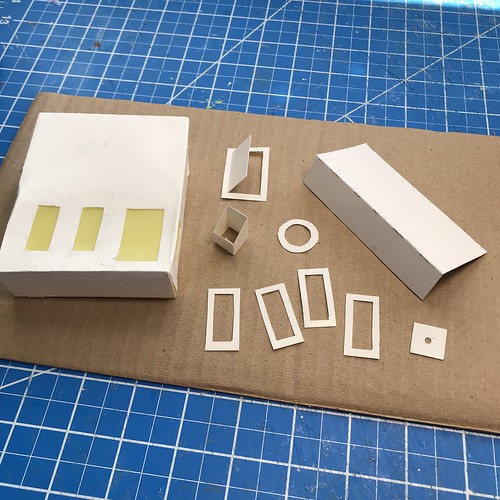
Before we start to paint the building, I’ll go over what I do to prepare paint. You can definitely use acrylic paint straight from the bottle to paint your Putz houses. I like to add a few things. I don’t normally measure things out, but I did for the purpose of this tutorial to make it clear what I’m doing.
I start with the paint. For these instructions, I measured 14 grams of acrylic paint into a small container.

I added 14 grams of white glue and 3 grams of Floetrol.

Mix it all together.
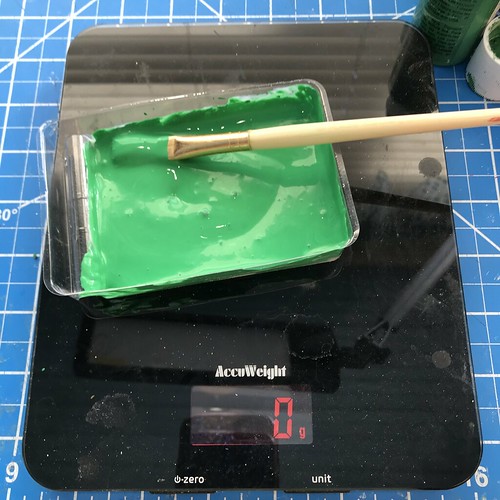
I add fine, clean sand to the mix. I was going for 14 grams, but topped it out at 16. There’s no right or wrong.
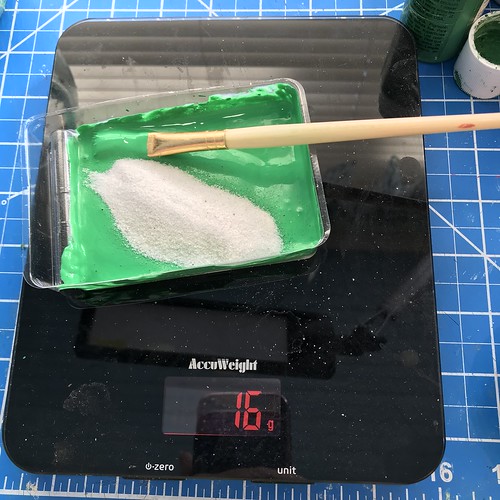
Mix well. I dabbed a little on the cardboard to see if it had enough sand in it. Looks good. This will be plenty of paint, with some left over. I bought some plastic bottles to hold extra paint. I turn to these first when choosing colors for a new Putz.

In my paint drawer, the paints I’ve mixed myself are stored on the right side of the drawer. I paint the tops so it’s easy to see all the colors without removing anything. I love my paint drawer…

When I’m ready to paint, I separate the pattern pieces into piles according to the color they will be painted. I give each piece two coats, waiting between coats for the first one to dry before painting the second one.
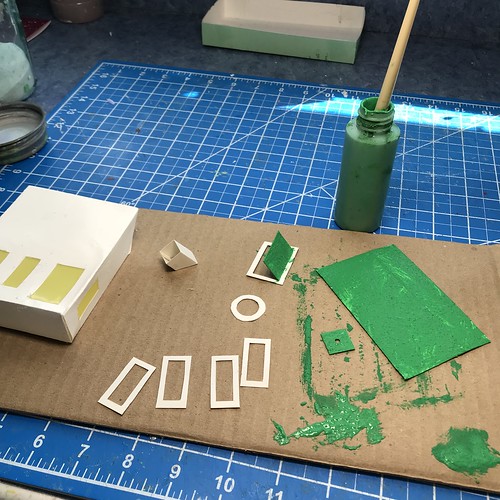
Because I am using poly film in the windows, I don’t worry about getting paint on them because, once it is dry, it will come off easily with the use of a beveled wooden pick. This won’t work if you are adding paper windows. Paint carefully!

Note the cleaned up windows:
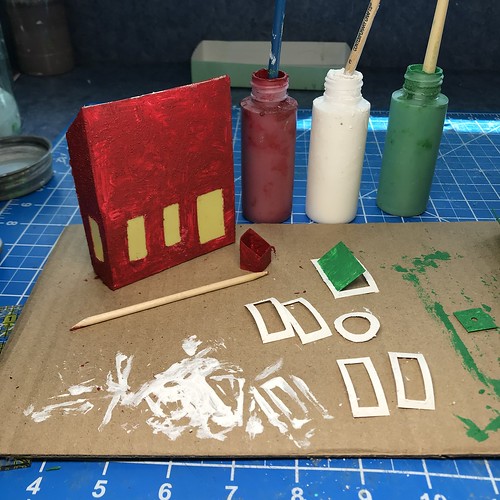
The first coat of paint will be uneven, both the paint and the sand. The second coat will even it out. Here it is after the second coat and before the glitter is applied. Paint and glitter larger pieces one side at a time.
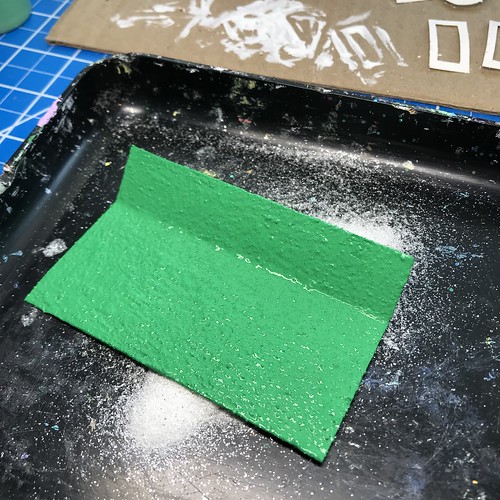
After the glitter is applied, allow the roof to dry a bit before doing the other side. While I work with the roof, I bend the fold now and then to keep it from drying flat.
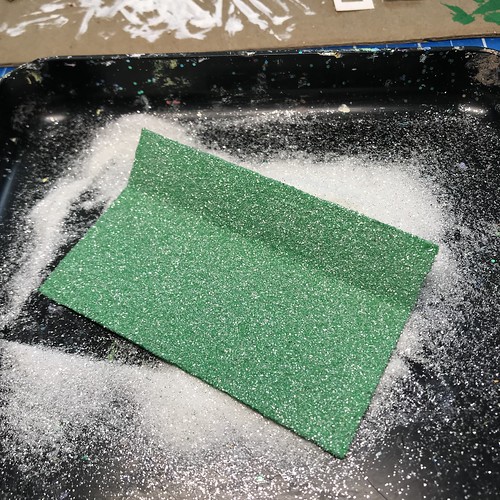
The small pieces can be painted on both sides, then dipped into the glitter.
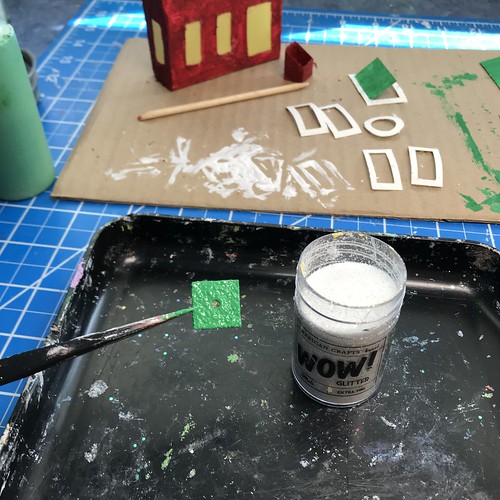


If the small piece is too large to fit in the glitter container, the glitter can be spinkled on both sides, over a glitter tray.

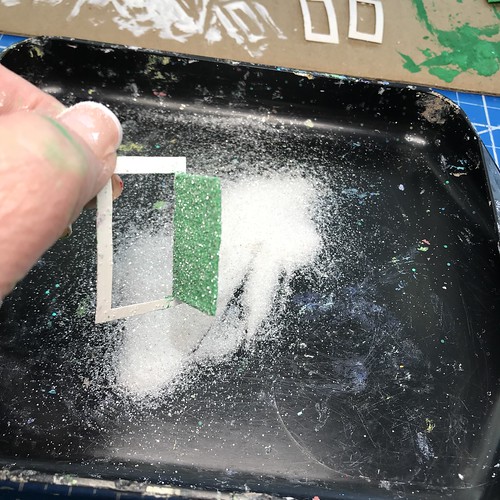
I paint the outside and the inside of the chimneys. The paint gives strength to the chimney.


I tried to catch the light in this picture to show how the first coat looks when dry.
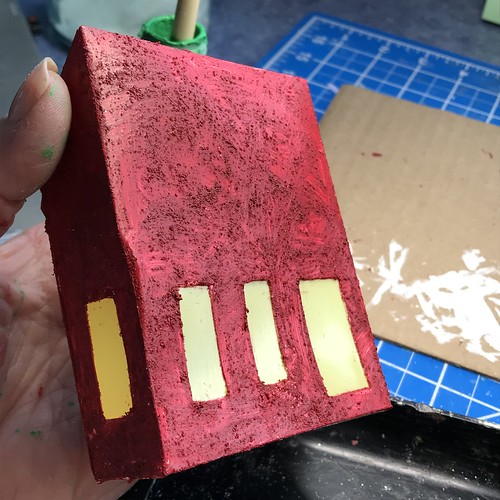
Second coat, still wet…

I paint and glitter one side at a time.

To glitter the back of the Putz, I put a little glitter down in the glitter tray, gently set the Putz front-down on the glitter, then I glitter the back.

Everything is glittered. At this point set the pieces aside and let them dry.

When dry, gently sand the backs of the frames to make them easier to glue to the Putz building.
Sand the top of the roof to remove bumps. This will ensure the roof will glue down tightly.

Sand the top of the chimney.
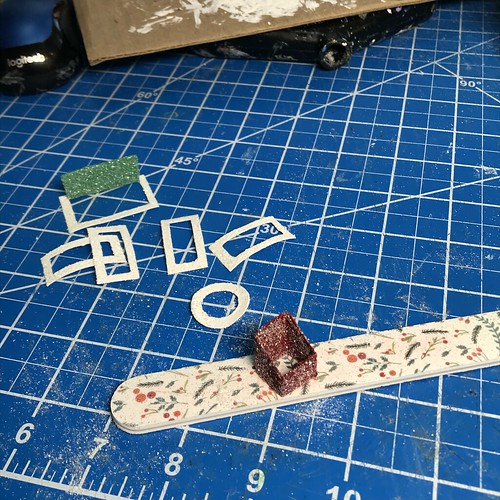
Glue the chimney cap on. Putting glue on both pieces helps it adhere tightly.
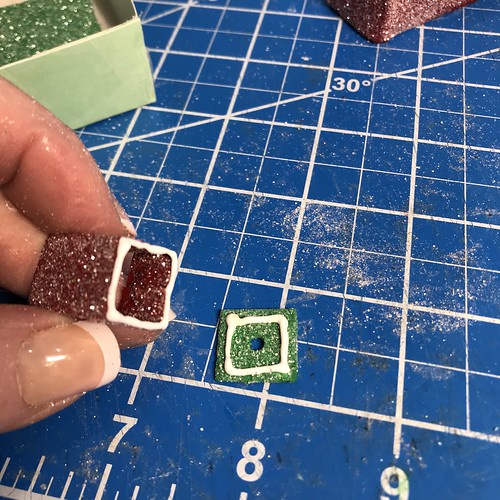
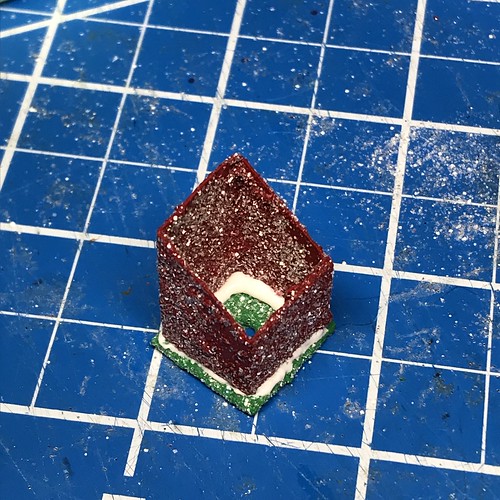
While the chimney dries, glue the frames to the house. Again, add glue to both pieces. Around the hole and on the back of the frame.
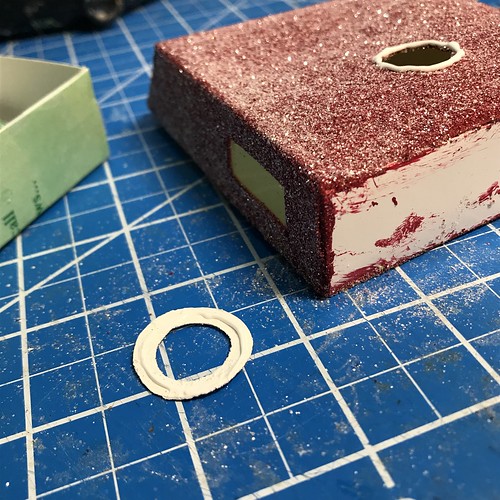

For applying the glue in a neat line, I use a fine-tip glue bottle. The bottle works best, when using tacky glue, if it is kept at least half full. I close the tip by putting a large straight pin in it. This keeps the glue from drying in the tip.

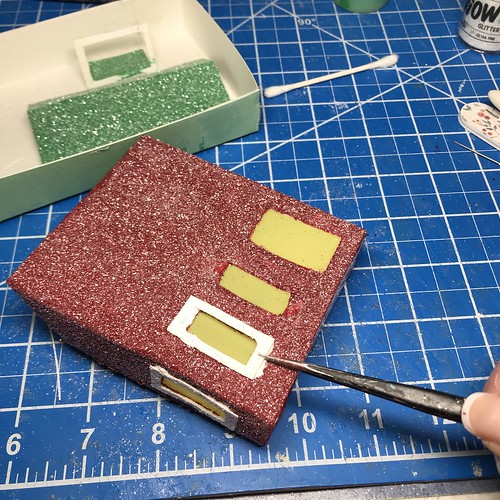
When all the frames are on, check them and pat down any that may have a gap. They will tighten down a bit as the glue dries, too.
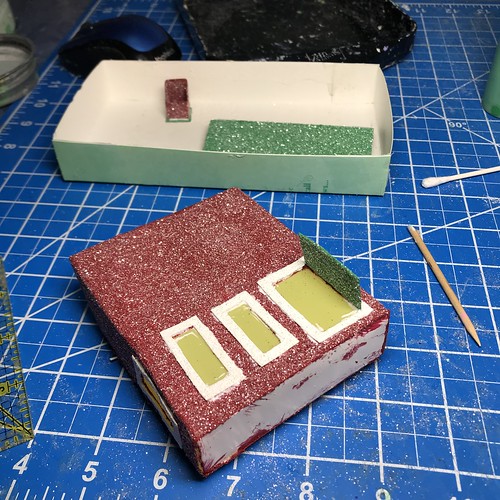
Gently bend the roof and check it on the house for fit. Glue it to the top of the house.
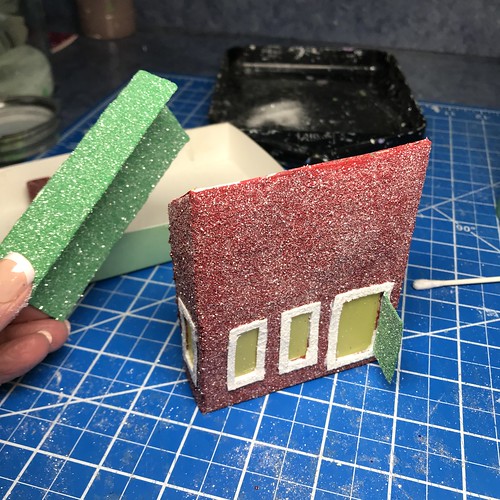

I use a dampened Q-tip to give a final cleaning to the poly film windows.

I apologize for the unfocused picture. I will retake and replace it when I make my next tree lot. To attach the chimney to the house, check it against the roof for placement. Put a bead of glue inside the chimney and set it on the roof.
A bead of white, tacky glue can be added around the base of the chimney on the outside if it seems to need the extra support. That will dry clear and, most likely, will be covered with snow.

Sometimes, even if the roof is bent during the painting phase, the paint may crack along the crease when it is dry and the roof is placed in its final position.

Use a fine-tipped paint brush and paint over the white areas, then glitter. It will probably be covered with snow anyway, but this ensures it looks good if any part isn’t covered.

Let the paint dry completely. The next step is to choose a base. That is covered in Part 3 of this tutorial.
Part 3 / Adding a Base and Embellishments
You can see my Putz houses and other Christmas ornaments in my Etsy shop.
If you are interested in more information about crafting Putz houses of your own, check out all my Putz tutorials.
I am always happy to answer questions about the process. Please ask, if you have questions about any part of this tutorial, or if you are wondering about other details of putzing.
All proceeds from my Etsy shop benefit Kenya Mercy Ministries. They work with the urban poor of Nairobi, Kenya, particularly the children and their families who live in Kibera, the largest slum in Africa. Thank you for your part in helping these children when you purchase items from my shop!
~~Rhonda
2 Comments
Awesome Rhonda…it is really easy to follow what you have said. Glad your doing this..:O)
I’m making a Putz house village and want to bknow if I have to use Primer.
I’m making withe prefab cardboard like materials sent to me from an order.
Please give me reply as soon as possible.
Thank you